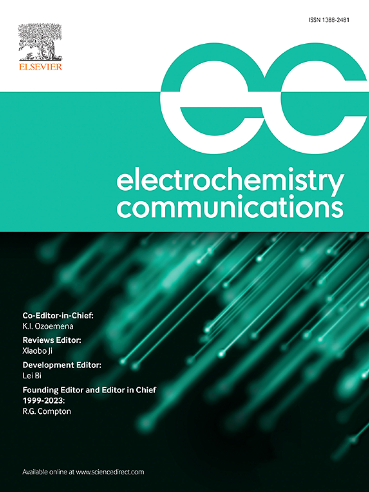多通道Hcy/FA配体传感器和cTnT免疫传感器在h型高血压和心肌梗死早期筛查中的应用
IF 4.2
3区 工程技术
Q2 ELECTROCHEMISTRY
引用次数: 0
摘要
同型半胱氨酸(Hcy)水平升高和叶酸(FA)水平降低在h型高血压(HTH)患者中经常观察到。然而,HTH增加了Hcy对急性心肌梗死(AMI)风险的重复性、再现性和稳定性。心肌肌钙蛋白T (cTnT)水平升高在AMI患者中尤为显著。然而,由于缺乏一种可靠、经济、快速的方法来准确预测、及时检测和有效指导这些疾病的治疗,Hcy、FA和cTnT的有效检测仍然具有挑战性。为了解决这一问题,开发了基于多电化学系统的Hcy和FA适配传感器以及cTnT免疫传感器。在1 ~ 100 μM和10 ~ 50 nM范围内,Hcy和FA浓度与相对氧化还原峰电流呈良好的线性关系,这是由于适体的构象变化所致。同样,cTnT的浓度与电极的相对氧化还原峰电流在1-60 pg/mL范围内表现出良好的线性关系,这归因于抗原-抗体结合后电子转移的变化。实验结果证实,适体传感器和免疫传感器具有良好的重复性、再现性、稳定性和特异性。在实际血清样品中,该生物传感器显示出可接受的回收率。这些发现表明,所提出的传感器在HTH和AMI的早期检测中具有重要的潜力。本文章由计算机程序翻译,如有差异,请以英文原文为准。

Multi-channel Hcy/FA aptasensors and cTnT immunosensors used for early screening of H-type hypertension and myocardial infarction
Elevated levels of homocysteine (Hcy) and decreased levels of folic acid (FA) are frequently observed in individuals with H-type hypertension (HTH). However, HTH increases Repeatability, reproducibility and stability of Hcy aptasensorrisk of acute myocardial infarction (AMI). Elevated cardiac troponin T (cTnT) levels are particularly significant in patients with AMI. Nevertheless, the effective detection of Hcy, FA, and cTnT remains challenging due to the lack of a reliable, cost-effective, and rapid method that can accurately predict, promptly detect, and effectively guide the treatment of these conditions. To address this issue, aptasensors for Hcy and FA as well as immunosensors for cTnT were developed based on amultiple electrochemical system. The concentration of Hcy and FA exhibited a good linear relationship with the relative redox peak current within the ranges of 1–100 μM and 10–50 nM, respectively, due to conformational changes in the aptamer. Similarly, the concentration of cTnT demonstrated a good linear relationship with the relative redox peak current of the electrode within the range of 1–60 pg/mL, attributed to changes in electron transfer following antigen-antibody binding. The experimental results confirmed that the aptasensors and immunosensors exhibited excellent repeatability, reproducibility, stability, and specificity. In real serum sample, this biosensor showed an acceptable recovery rate. These findings suggest that the proposed sensors hold significant potential for the early detection of HTH and AMI.
求助全文
通过发布文献求助,成功后即可免费获取论文全文。
去求助
来源期刊

Electrochemistry Communications
工程技术-电化学
CiteScore
8.50
自引率
3.70%
发文量
160
审稿时长
1.2 months
期刊介绍:
Electrochemistry Communications is an open access journal providing fast dissemination of short communications, full communications and mini reviews covering the whole field of electrochemistry which merit urgent publication. Short communications are limited to a maximum of 20,000 characters (including spaces) while full communications and mini reviews are limited to 25,000 characters (including spaces). Supplementary information is permitted for full communications and mini reviews but not for short communications. We aim to be the fastest journal in electrochemistry for these types of papers.
 求助内容:
求助内容: 应助结果提醒方式:
应助结果提醒方式:


